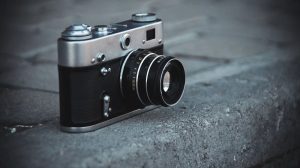
Have you observed that both novice and seasoned photographers are showing a revived interest in film photography? Choosing their first film cameras can be overwhelming for many people due to the vast array of alternatives available.
The good news is that you can start taking stunning film pictures without expensive equipment or technical expertise. For those who are new to film photography, the correct camera can make all the difference.
Based on pricing, photo quality, and ease of use, this list will show you the best film cameras for novices. For novice photographers, each choice has something unique to offer.
for novices. For novice photographers, each choice has something unique to offer.
Are you prepared to begin your photography hobby with the ideal film cameras? Let’s examine the top options for novices.
What Makes a Film Camera Beginner-Friendly?
When you’re first starting out, it’s important to get the correct film cameras. An excellent entry-level camera should be affordable and easy to operate. Clear controls in the finest ones allow you to learn as you go. They ought to be resilient enough to deal with little setbacks that occur when you’re still learning the ropes.
Important elements that make film cameras ideal for novices:
- Easy-to-use controls with minimal adjustment settings
- Integrated light meters that support appropriate exposure
- Reasonably priced, both the camera and the film
- Options for manual focus that are visible and unambiguous
- robust construction that can tolerate little bumps
- Popular film formats that are readily accessible (35mm)
- Simple lens choices without intricate add-ons
These features allow novice photographers to concentrate on time and composition instead of becoming bogged down in intricate technical minutiae.
Disclaimer: This blog is not sponsored by or associated with any brands; all product recommendations are based only on personal experience.
Best film cameras: Top 5 Beginner
With a beginner-friendly camera, there’s no better way to get started with the resurgence of film photography.
For those who are new to film photography, these five cameras provide the ideal balance of price, dependability, and pleasure, regardless of your preference for fully manual control or something with a little more automation.
1. Canon AE-1
The Canon AE-1 is distinguished by its sturdy construction and intuitive controls. New users can get good images without knowing all the technical nuances thanks to its shutter speed-priority mechanism. As you advance, you can also experiment with a variety of reasonably priced Canon FD lenses.
Why it’s the best Beginners are guided toward appropriate exposure by the AE-1’s excellent viewfinder and useful light meter without feeling overly complicated.
2. Nikon FM10
The Nikon FM10 is quite straightforward. With its fully manual settings and integrated light meter, this camera provides a step-by-step guide for novices to learn the fundamentals of exposure. The learning process is made clearer by its simple design. Customers have several options because most Nikon F-mount lenses are compatible with the camera.
Why it’s the best It is highly steady for novice photographers because of its battery-free mechanical shutter, which operates even without electricity.
3. Minolta X-700
A seamless transition from novice to expert photographer is provided by the Minolta X-700. It has three shooting modes—manual, auto, and program—so you may choose how much control you like. Via the bright viewfinder, all pertinent information is clearly apparent. This camera is comfortable to hold and light enough to shoot all day.
Why it’s the best Beginners can concentrate just on time and framing because the program mode takes care of both shutter speed and aperture for them.
4. Pentax K1000
The Pentax K1000 has been a widely used teaching tool in photography classes for many years. This simple manual camera just has a light meter, a clear focus screen, and controls that are straightforward to use. Numerous little bumps won’t cause any issues for its metal body. You can learn the fundamentals of photography without interruptions with the K1000.
Why it’s the best Because of its simple design, novices are forced to learn the fundamentals of focus and exposure without depending on auto settings.
5. Olympus OM-10
The Olympus OM-10 is a compact device with a lot of useful functions. Because of its small size, it’s convenient to carry around, which increases practice opportunities. While the camera manages shutter speed, the aperture-priority mode assists novices in controlling depth of field. Learning is accelerated by the OM-10’s intuitive controls.
Why it’s the best Because of its compact size and low weight, it’s the ideal camera to carry about at all times, which is essential for developing abilities through regular practice.
How to Pick the Best Film Cameras for Your Needs
Selecting your first film camera may be challenging with so many possibilities. It’s important to align the camera with your goals and requirements. Spend some time considering your photography goals before making a purchase.
First, create a precise budget. Film cameras range in price from $50 to several hundred dollars. Budget for extra costs for things like film, processing, and extra lenses.
Consider the type of photos you want to take. If you want to take street photos, a little camera might be perfect for you. For landscapes, you might need something with good manual controls.
Think about your favorite learning style as well. Do you prefer to begin with every manual setting? Or are you more interested in learning with some automated features?
If you can, try holding different cameras. How a camera feels in your hands has a big impact on how frequently you use it.
Consider these questions:
- What is my spending limit?
- Do I want complete manual control or automatic features?
- Which weight and size are comfortable for me?
- To what extent are parts and films for this model available?
- Will I soon require additional lenses?
You should be delighted to snap pictures with your first film cameras. You’ll be more inclined to use it frequently and advance your abilities if you discover one that feels right and falls within your budget.
Tips for Taking Great Photos with Your First Film Cameras
Start with the Correct Film: For good all-around use, pick films with an ISO of 400. In the majority of lighting situations, this speed performs effectively. See which style you like best by watching both color and black-and-white movies. Try a few different film brands to see which one you like most because they all have unique looks and feels.
Learn to Load Film Correctly: For the first few times, load the film slowly. Make sure that the take-up spool is correctly capturing the film. Always close the rear in low light or shadow to avoid exposure issues.
Master Focus First: The quality of a photograph is greatly impacted by sharp focus. Try pre-focusing on a location where moving subjects are likely to be. It takes work to focus well, but it soon becomes instinctive.
Recognize the Light Meter: The light meter on your camera aids in obtaining the proper exposure. Your settings are good when the LED or needle is centered. Your image will be very bright if the meter displays a + sign. Until the meter displays a balanced reading, adjust your settings.
Be Aware of Every Shot: Since there are only 24 or 36 shots on a roll, film encourages you to consider your shot before taking it. Make a thorough plan for your writing. Await the appropriate time. You will eventually become a better photographer as a result of this methodical technique.
Monitor Your Settings: Make a note of the settings you applied to every roll. If at all feasible, note the shutter speed, aperture, ISO, and film type. This enables you to grow over time by learning from your outcomes.
Build a Relationship with a Reputable Lab: Look for a reputable photo lab that can appropriately develop your film. Inquire and benefit from their knowledge. A quality lab can offer advice and assist in resolving issues with your images. They turn into important collaborators on your filmmaking adventure.
Accept Mistakes: Errors may provide some of your best images. Unusual colors, double exposures, or light leaks can provide distinctive results. Remain receptive to outcomes that don’t match your expectations.
In conclusion: Best film cameras
Digital photography lacks the care and consideration that film photography imparts. The cameras we examined provide straightforward routes into this fulfilling pastime without complicated features that could be confusing.
Keep in mind that your initial film camera is only a beginning step. You’ll discover your own style as you gain more knowledge about exposure, focus, and composition; you could eventually need different equipment.
Carry it with you everywhere. Capture diverse topics in a range of lighting conditions. Make errors and grow from them.
The excitement of watching your vision come to life on film and the satisfaction of waiting for your images to be processed are what really count.
Recent Posts
The inexpensive How to use disposable camera provides a welcome, sentimental look back at simpler times in a time when digital photography is king. With film already loaded, these small,...
The emergence of digital technology changed the landscape of photography and brought about a period of never-before-seen convenience, adaptability, and creativity . Digital...
